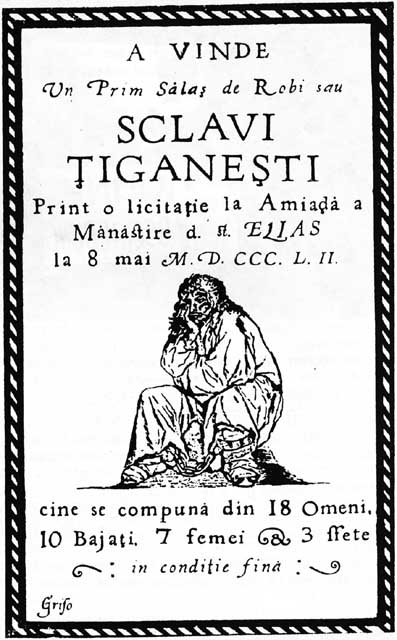
An 1852 poster advertising an auction of Roma slaves in Bucharest, Romania.
Slavery of Roma people (Gypsies) existed on the territory of present-day Romania from before the founding of the principalities of Wallachia and Moldavia in 13th–14th century, until it was abolished in stages during the 1840s and 1850s.
The slaves were considered personal property of the master. They were objects of exchange, sometimes sold by weight; a Rom could be sold for a smaller price than two copper pots, a Roma child could be bought for a smaller price than a cow, because she was not yet good capable of working full-time. Masters offered Roma girls as pleasure toys to their guests; they had the right of life and death over the slave.
The master was allowed to punish his slaves physically, through beatings or imprisonment. 1821, at a time when Boyars in Moldavia fled their country to escape the Eterist expedition, Austrian authorities in Bukovina were alarmed to note that the newly-settled refugees made a habit of beating their slaves in public, and consequently issued an order specifically banning such practices. A dispute followed, after which the Boyars received permission to carry on with the beatings, as long as they exercised them on private property.
The master was allowed to punish his slaves physically, through beatings or imprisonment. 1821, at a time when Boyars in Moldavia fled their country to escape the Eterist expedition, Austrian authorities in Bukovina were alarmed to note that the newly-settled refugees made a habit of beating their slaves in public, and consequently issued an order specifically banning such practices. A dispute followed, after which the Boyars received permission to carry on with the beatings, as long as they exercised them on private property.

A Shatra or Roma(Gypsy) slave village, Romania, 1850s.
In a gradual, step-by-step process, Roma began to lose their cultural identity and internalise their inferior status in society. Ashamed of themselves, perceiving their ethnic identity as damnation, they were stigmatised and excluded from the society of their former masters. Roma thus became a scapegoat for all the frustrations and failures of Romanian society.




0 comments:
Post a Comment